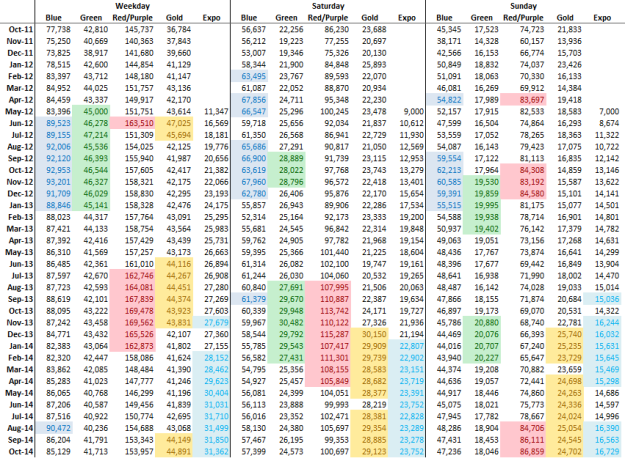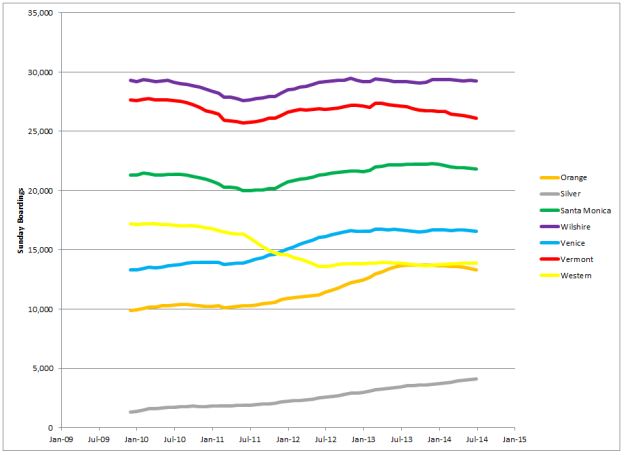Note: see the update to bus ridership here.
Another three months has passed, so it’s time for another LACMTA rail ridership update.
First, the raw data. Highlighted cells represent the top 10 months for that line (since January 2009).

Ridership was generally up a little bit on all lines. The Green and Blue Lines remain well below their peak ridership months in the second half of 2012, as is the Red Line below peak months in 2013. Gold Line ridership remained near all-time highs, while Expo Line was flat except for Sunday ridership. Expo Line ridership was flat in the second half of 2013 as well, so we’ll have to see if 2015 brings another surge. Trends were similar across weekdays, Saturday, and Sunday, except for the Red Line on Sundays, which had some of its best numbers on record.
Here’s the rolling 12-month average of weekday ridership:

On the rolling 12-month graphic, the recent dips in Blue and Green Lines ridership look a little less troubling. The sharp drop in Red Line ridership is likely due to fare gate locking.
For this update, I decided to include the Saturday and Sunday rolling 12-month averages as well.


Note the sharp uptick in Gold Line ridership on Saturday and Sunday starting in July 2013, while weekday ridership is little changed. This is probably because Metro started running 7-8 minute headways on the Gold Line on weekends. While this is nice for Gold Line riders and led to a bump in ridership, you have to wonder why the Green Line – which has identical ridership overall and on a per mile basis – only gets 15 minute service on the weekend, and the Blue Line, with higher ridership, gets 10 minute service.
Boardings per mile is a better way to look at productivity. Here’s the update for the rolling 12-month average of boardings per mile:

Now Featuring Bus Ridership!
As experts like Jarrett Walker and Juan Matute have written elsewhere, an extensive, successful rail network will only be part of a successful transit network for LA. Bus will always be important. With that in mind, here’s a look at ridership trends on five of LA’s major arterials. Each arterial has both a local bus route and a Metro Rapid bus (700-series route numbers). Therefore, the ridership presented is the sum of the local and the rapid. The chosen arterials and bus routes are Santa Monica (4 & 704), Wilshire (20 & 720), Venice (33 & 733), Vermont (204 & 754), and Western (207 & 757). The Orange Line and Silver Line are also included.
Here’s the raw data, and the rolling 12-month averages for weekdays.


Orange Line and Silver Line ridership grew steadily throughout the period, and Wilshire and Venice had growth as well. Santa Monica was flat, while both Vermont and Western saw considerable drops in ridership – nearly 12% in the case of Vermont.
Here’s the Saturday and Sunday rolling 12-month averages.


On the Saturday and Sunday graphics, we can see some interesting structural changes reveal themselves. The 733 service on Venice was introduced in July 2010, and this seems to have resulted in an increase in ridership. Meanwhile, the 757 service on Western was discontinued on weekends in July 2011, and this seems to have resulted in an immediate drop in ridership. By late 2012, ridership on both streets had leveled off. This change is also evident in weekday ridership on Venice, though not as pronounced.
Lastly, we can look at the percentage of trips on each arterial being served by the rapid route.

The 720 dominates ridership on the Wilshire corridor. On Venice, the rapid captured about 50% of ridership when introduced, and has since slipped a little. On Western, service changes in July 2011 resulted in a quick jump in rapid share, followed by a continued increase. Vermont also saw a slight increase in rapid share, though in both the case of Western and Vermont, total ridership on the corridor declined.
It’s impossible to discern what caused ridership changes from this data. An improving economy means more people have jobs, which increases ridership, but it also means more people can afford cars. Some of the neighborhoods served by these routes have been undergoing changes that often decrease ridership, such as gentrification.
There are two ideas I would feel comfortable floating out. One, because the Silver Line on the 110 is just a little over half a mile from Vermont, some Silver Line ridership may have been captured from Vermont. The Silver Line is limited by poor stop spacing, but it goes directly downtown, so it may have captured trips from Vermont that were transferring to the Red Line. Two, the Expo Line may have captured some ridership in the USC area.
The most important thing here, though, is that ridership on these bus corridors is higher than many of LA’s LRT lines. Wilshire and Vermont have more riders than any LRT line except the Blue Line. These bus routes are a critical part of mobility in LA. We’ll have Wilshire BRT, but maybe we should have a Vermont, Western, Santa Monica, and Venice BRT too.
That’s it for now, stay tuned for Metrolink!





























